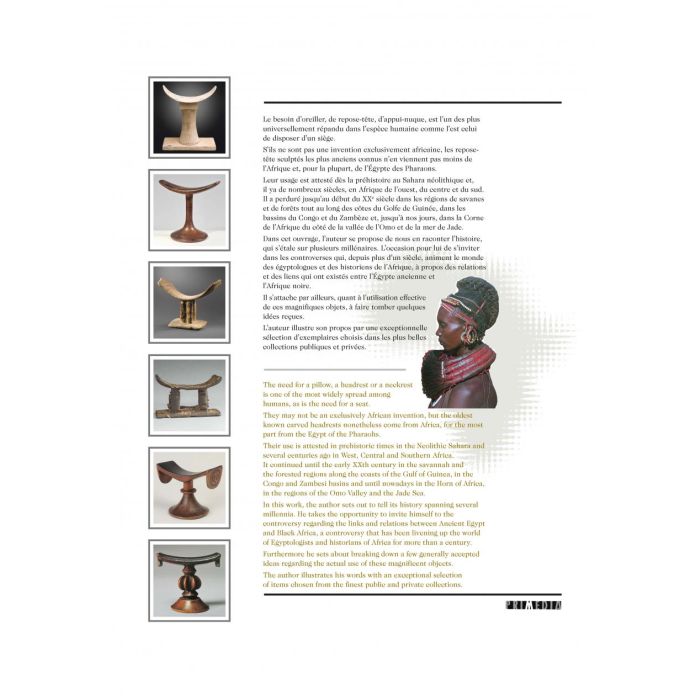My Cart
Your cart is empty
Looks like you haven't made your choice yet.
- Subtotal
Sur la Piste de l'Éléphant… et celle d'Abou Ballas

De l'usage des repose-tête en Afrique, de la préhistoire jusqu'à nos jours
- Pirat/ Primedia
- by de Claude-Henri Pirat
More Information
| Publisher | Pirat/ Primedia |
|---|---|
| ISBN | 9782960137552 |
| Author(s) | de Claude-Henri Pirat |
| Publication date | December 2021 |
| Edition | Hardback |
| Dimensions | 300 x 240 mm |
| Illustrations | 800 col. & bw ill. |
| Pages | 296 |
| Language(s) | Eng/ French edition |
Description
The need for a pillow, a headrest or a neck rest is one of the most widely spread among humans, as is the need for a seat. They may not be an exclusively African invention, but the oldest known carved headrests nonetheless come from Africa, for the most part from the Egypt of the Pharaohs. Their use is attested in prehistoric times in the Neolithic Sahara and several centuries ago in West, Central and Southern Africa. It continued until the early XXth century in the savannah and the forested regions along the coasts of the Gulf of Guinea, in the Congo and Zambesi basins and until nowadays in the Horn of Africa, in the regions of the Omo Valley and the Jade Sea.
In this work, the author sets out to tell its history spanning several millenia. He takes the opportunity to invite himself to the controversy regarding the links and relations between Ancient Egypt and Black Africa, a controversy that has been livening up the world of Egyptologists and historians of Africa for more than a century. Furthermore he sets about breaking down a few generally accepted ideas regarding the actual use of these magnificent objects.
The author illustrates his words with an exceptional selection of items chosen from the finest public and private collections.
Le besoin d'oreiller, de repose-tête, d'appui-nuque, est l'un des plus universellement répandu dans l'espèce humaine comme l'est celui de disposer d'un siège. S'ils ne sont pas une invention exclusivement africaine, les reposetête sculptés les plus anciens connus n'en viennent pas moins de l'Afrique et, pour la plupart, de l'Égypte des Pharaons. Leur usage est attesté dès la préhistoire au Sahara néolithique et, il ya de nombreux siècles, en Afrique de l'ouest, du centre et du sud. Il a perduré jusqu'au début du XXe siècle dans les régions de savanes et de forêts tout au long des côtes du Golfe de Guinée, dans les bassins du Congo et du Zambèze et, jusqu'à nos jours, dans la Corne de l'Afrique du côté de la vallée de l'Omo et de la mer de Jade.
Dans cet ouvrage, l'auteur se propose de nous en raconter l'histoire, qui s'étale sur plusieurs millénaires. L'occasion pour lui de s'inviter dans les controverses qui, depuis plus d'un siècle, animent le monde des égyptologues et des historiens de l'Afrique, à propos des relations et des liens qui ont existés entre l'Égypte ancienne et l'Afrique noire. Il s'attache par ailleurs, quant à l'utilisation effective de ces magnifiques objets, à faire tomber quelques idées reçues.
L'auteur illustre son propos par une exceptionnelle sélection d'exemplaires choisis dans les plus belles collections publiques et privées.
The need for a pillow, a headrest or a neck rest is one of the most widely spread among humans, as is the need for a seat.
They may not be an exclusively African invention, but the oldest known carved headrests nonetheless come from Africa, for the most part from the Egypt of the Pharaohs.
Their use is attested in prehistoric times in the Neolithic Sahara and several centuries ago in West, Central and Southern Africa. It continued until the early XXth century in the savannah and the forested regions along the coasts of the Gulf of Guinea, in the Congo and Zambesi basins and until nowadays in the Horn of Africa, in the regions of the Omo Valley and the Jade Sea
In this work, the author sets out to tell its history spanning several millenia. He takes the opportunity to invite himself to the controversy regarding the links and relations between Ancient Egypt and Black Africa, a controversy that has been livening up the world of Egyptologists and historians of Africa for more than a century.
Furthermore he sets about breaking down a few generally accepted ideas regarding the actual use of these magnificent objects.
The author illustrates his words with an exceptional selection of items chosen from the finest public and private collections.
